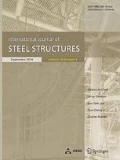Abstract
This paper describes a study on improving redundancy in a 240 m span steel Pratt truss bridge. Redundancy was evaluated from two perspectives. The first perspective was how many members would induce bridge collapse owing to their own damage, and the second perspective was how many members would be damaged owing to another member’s damage. Members corresponding to these two perspectives were widely present throughout the subject truss bridge. As a measure to improve redundancy of the subject truss bridge, the method of installing alternative load paths by retrofitting additional braces was studied. Three proposals with different geometry of the additional braces were compared, and "X bracing", which equipped X-shaped braces by adding braces in the opposite direction to the existing diagonal member, demonstrated excellent performance. In addition, the effect of the method retrofitting the cable along the member was also studied. Next, the placement patterns of "X bracing" on 18 truss panels of the subject truss bridge were examined using an optimization technique. It was clarified that examination of the placement for the additional braces was important for the efficient improvement of redundancy, and that the optimum placement of X bracing was in the alternating areas. Finally, the buckling gusset plate of the I-35 W bridge was also in the alternating area, suggesting that reinforcement of the alternating area might be important for redundancy of truss bridges.











Similar content being viewed by others
References
AASHTO. (2002). AASHTO Standard specifications for highway bridges. American Association of State Highway and Transportation Officials.
AASHTO. (2007). AASHTO LRFD bridge design specifications. American Association of State Highway and Transportation Officials.
Abdollahzadeh, G., & Shalikar, R. (2017). Retrofitting of steel moment-resisting frames under fire loading against progressive collapse. International Journal of Steel Structures, 17(4), 1597–1611.
Fiorillo, G., Miao, F., & Ghosn, M. (2016). Direct redundancy evaluation of bridges designated as fracture-critical. Journal of Performance of Constructed Facilities. https://doi.org/10.1061/(ASCE)CF.1943-5509.0000798
Goto, Y., Kawanishi, N., & Honda, I. (2010). Dynamic stress amplification caused by sudden failure of tension members in steel truss bridges. Journal of the Structural Engineering. American Society of Civil Engineers. https://doi.org/10.1061/(ASCE)ST.1943-541X.0000338
Hao, S. (2010). I-35W Bridge Collapse. Journal of Bridge Engineering. https://doi.org/10.1061/(ASCE)BE.1943-5592.0000090
Japan Road Association. (1980). Specification for highway bridge (in Japanese).
Japan Road Association. (2012). Specification for highway bridge (in Japanese).
Khuyen, H., & Iwasaki, E. (2017). Linear redundancy analysis method considering plastic region for steel Truss Bridges. Journal of Bridge Engineering. https://doi.org/10.1061/(ASCE)BE.1943-5592.0000999
Liao, M., Okazaki, T., Ballarini, R., Schultz, A. E., & Galambos, T. V. (2011). nonlinear finite-element analysis of critical gusset plates in the I-35W Bridge in Minnesota. Journal of the Structural Engineering. American Society of Civil Engineers. https://doi.org/10.1061/(ASCE)ST.1943-541X.0000269
Lin, W., Yoda, T., Kumagai, Y., & Saigyo, T. (2013). Numerical study on post-fracture redundancy of the two-girder steel-concrete composite highway bridges. International Journal of Steel Structures, 13(4), 671–681.
Minnesota, D. O. T. (2006). Fatigue evaluation and redundancy analysis, Bridge No.9340, I-35W over Mississippi river. URS Corporation, Minneapolis.
Mirjalali, H., Ghasemi, M., & Labbafzadeh, M. S. (2019). Effect of bracing type and topology on progressive collapse resistance of eccentrically braced frames. International Journal of Steel Structures, 19(5), 1497–1510.
Nagatani, H., et al. (2009). Structural redundancy analysis for steel truss bridges in Japan. Journal of Japan Society of Civil Engineers, Division A, 65(2), 410–425.
Nonaka, T., et al. (2010). A proposal for redundancy analysis of steel bridges including progressive member failures. Journal Structural Engineering, 56(1), 779–791. in Japanese.
Park, Y., Joe, W., Park, J., Hwang, M., & Choi, B. H. (2012). An experimental study on after-fracture redundancy of continuous span Two-girder Bridges. International Journal of Steel Structures, 12(1), 1–13.
Salem, H. M., & Helmy, H. M. (2014). Numerical investigation of collapse of the Minnesota I-35W bridge. Engineering Structures, 59, 635–645.
Yoshioka, T., Okui, Y., Iwasaki, E. (2014). “Guidelines for redundancy and future works.” In Proceedings of the symposium on steel structures and bridges-17, pp. 97–104 (in Japanese).
Acknowledgements
Financial support from Chugoku Kensetsu Kousaikai for this study is gratefully acknowledged. The research team thanks Dr. Isamu Yoshitake and Mr. Takayuki Makihara for coordinating and assisting the load testing. We also thank Mr. Shouji Maekawa for fabricating specimens and Mr. Ryuichi Inoue for supporting the load testing. The authors would like to thank Enago (wwww.enago.jp) for English language review.
Author information
Authors and Affiliations
Corresponding author
Additional information
Publisher's Note
Springer Nature remains neutral with regard to jurisdictional claims in published maps and institutional affiliations.
Rights and permissions
About this article
Cite this article
Tajima, K., Ishiguro, H. & Aso, T. Study on Redundancy Improvement for Truss Bridges Focusing on the Geometry and Placement Pattern of Additional Braces. Int J Steel Struct 21, 1145–1158 (2021). https://doi.org/10.1007/s13296-021-00509-7
Received:
Accepted:
Published:
Issue Date:
DOI: https://doi.org/10.1007/s13296-021-00509-7




